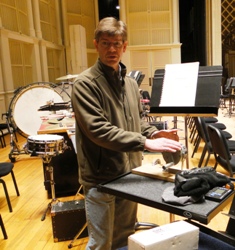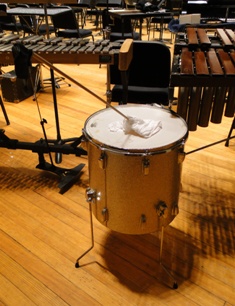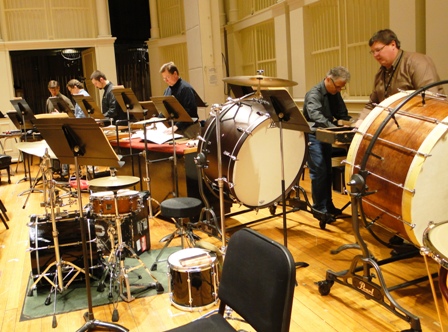
Varèse’s Mammoth "Amériques" Overflows with Percussion

That lion doesn’t bite, but it sure can roar.
It’s a good thing, too, because it’s going to be crowded back there.
The beast in question is part of the bestiary of percussion required to perform Edgar Varèse’s “Amériques” (1921) on Cincinnati Symphony Orchestra concerts at 8 p.m. Friday and Saturday (May 6 and 7) at Music Hall.
There will be twelve percussionists (14 counting the two timpanists), and they will wield everything from mallets and beaters to wire brushes and a wet handkerchief to get the sounds Varèse calls for in this ground-breaking work, his first after immigrating to the U.S. from France in 1915.

lion's roar
|
CSO principal percussionist David Fishlock
demonstrated the lion’s roar – also called string drum -- before rehearsal
Thursday morning at Music Hall. It works
on the principle of friction, he said. A
string is inserted through a small hole in the top of a drum. When pulled upward (with that wet hanky) it
produces a sound remarkably like the voice of the king of beasts.
The name “Amériques” implies that it reflects Varèse’s observations on his newly adopted country. And so it does, but it is more than that. He called it “discoveries of new worlds,” on earth, in the sky and the mind. Just as his contemporary Arnold Schoenberg declared the “liberation of dissonance,” Varese (1883-1965) wanted to liberate sound. He was a pioneer of electronic music and had a lifelong desire to develop new instruments. (He wrote for theremin – as in “It Came from Outer Space” -- and also ondes martenot, heard in the CSO’s “Turangalila Symphony” by Olivier Messiaen in March.)
A single movement of 23 minutes, “Amériques” is full of muscularity and power, a kind of American "Rite of Spring" (Stravinsky). In the original version, which requires an orchestra of 155 (even larger than the revised version to be heard
this weekend), the percussion section included crow call, steamboat whistle and cyclone
whistle in addition to the huge array that will take up nearly a quarter of the Music Hall stage.

Percussionists participating are David Fishlock (CSO principal percussionist), Bill Platt, Mark Wolfley, Bill Albin, Russell Burge, James Culley, Danny Frank, Matt Hawkins, Scott Lang, Mike La Mattina, Jeff Luft and Jerry Noble. All will play one or more of the instruments at hand: xylophone, chime, triangle, sleigh bells, low rattle, glockenspiel, whip, tambourine, gong, bass drum, ratchet, castanets, siren and snare drum. CSO percussionist Richard Jensen will play timpani along with principal timpanist Patrick Schleker. Fishlock will play snare drum.
The Music Hall stage will be full of other
instruments, too, 115 players-strong. Some will
double on more than one instrument.
There will be five flutes, including three piccolos and alto flute; five
oboes, including English horn, heckelphone (baritone oboe) and bass oboe; five
clarinets, including E-flat clarinet and bass clarinet; nine horns; six
trumpets; five trombones, including three tenors, bass and contra bass trombone;
two tubas, including bass and contra bass tuba; two sets of timpani; two harps and celeste.
Being a percussionist can mean being a hunter and a scavenger, said Fishlock who has played “Amériques” with the Cleveland Orchestra. In order to meet the requirements of a particular score, he has had to visit junkyards and second-hand stores to find exotic equipment like coiled springs and brake drums (from automobiles) and, for “Amériques,” a fire truck siren. “You just have to start poking around,” he said. He found the siren at a store that sells emergency equipment for police cars and fire engines. “They had a collection of old, mechanical hand-cranked instruments,” he said.
Varèse, it seems, was very taken with the sirens of New York City, Fishlock said. “He also wrote for the siren as an instrument with a continuous 12-tone pattern. In his mind, it was a way to connect all twelve pitches of a scale and create a continuum of pitch.”
One search took Fishlock to Wal-Mart. “I had to play clay pots on a piece a few years ago and I went to the Wal-Mart Garden Center with my mallet and started plinking away on all these different clay pots to try to get the right pitches. People thought I was nuts.”
“Usually, if you know what the object is that we have to play, it’s just a matter of finding where to get hold of it. The harder part is when you just don’t know what the composer is talking about. Sometimes we get instrument names that we just don’t know. Then we have to call around and see what everybody’s guess is.”
Most of the percussion used in “Amériques” is non-melodic, said Fishlock. “The xylophone and the glockenspiel are the only two melodic instruments and they are somewhat sporadic. The real instruments that are played steadily through are sleigh bells and castanets, snare drum and ratchet, the more rhythmic instruments.”
The emphasis on percussion – a prominent feature of
20th-century music in general – is carried out in Charles Coleman’s
“P.J. Fanfare,” which will open this week’s concerts and
Erkki-Sven Tüür’s
Piano Concerto and "Fireflower" (a fanfare dedicated to Järvi) which will be featured on the May 13 and 14 concerts. So much so that Gustav Mahler himself is
likely to be upstaged. That program, the final one of Järvi's tenure as CSO music director,
will conclude with Mahler’s Symphony No. 5.
“Mahler wrote so prolifically for percussion,” said Fishlock. His Symphony No. 5 calls for glockenspiel, cymbals, bass drum, side drum, triangle. slapstick (whip) and tam-tam (gong). Still, “compared to everything this weekend and in the Tüür, it will be comparatively empty.”
The CSO led by music director Paavo Järvi performs Edgar Varèse’s “Amériques” at 8 p.m. Friday and Saturday (May 6 and 7) at Music Hall. Also on the program are “P.J. Fanfare” by Charles Coleman, Aaron Copland’s Clarinet Concerto with guest artist Martin Fröst, Fugue from Charles Ives’ Symphony No. 4 (“From Greenland’s Icy Mountains”) and Three Dance Episodes from “On the Town” by Leonard Bernstein. Tickets begin at $10 and are available at www.cincinnatisymphony.org or by calling (513) 381-3300.